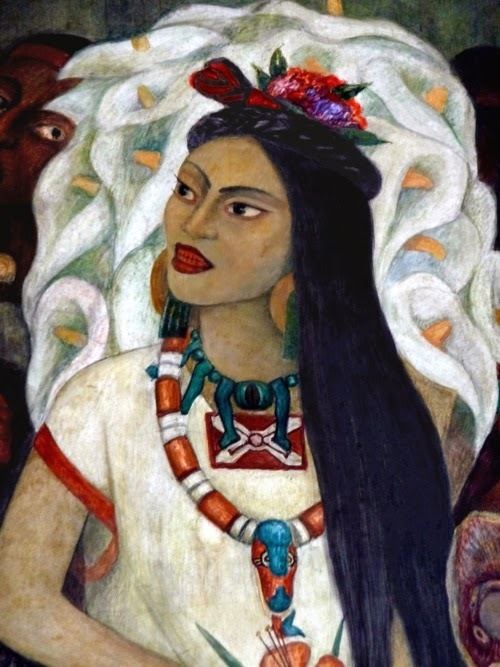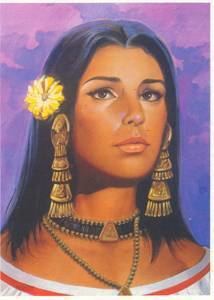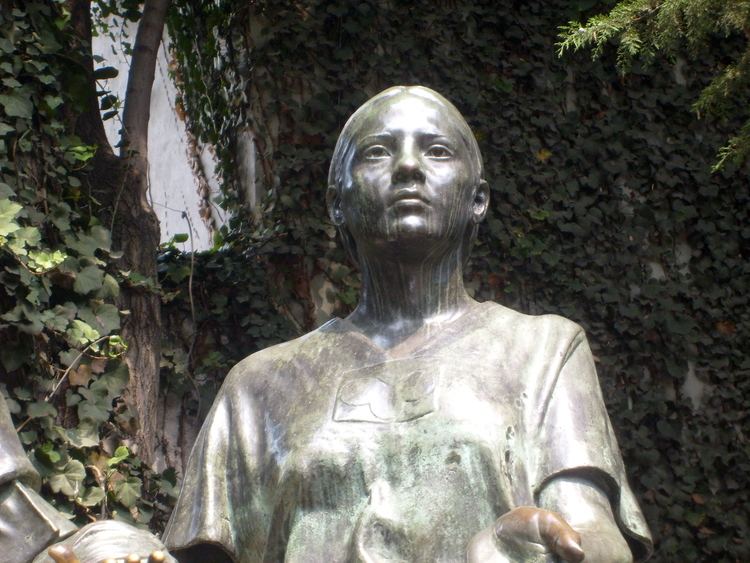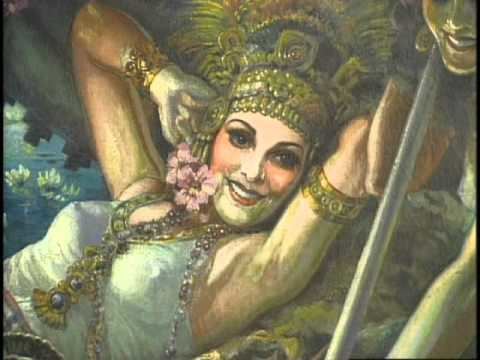Name La Malinche Children Martin Cortes | Role Interpreter Parents Chimalpain, Cimatl | |
 | ||
Similar People Hernan Cortes, Martin Cortes, Moctezuma II, Geronimo de Aguilar, Bernal Diaz del Castillo | ||
The Treasure of La Malinche Book Trailer
La Malinche ([la maˈlintʃe]; c. 1496 or c. 1501 – c. 1529), known also as Malinalli [maliˈnalːi], Malintzin [maˈlintsin] or Dona Marina [ˈdona maˈɾina], was a Nahua woman from the Mexican Gulf Coast, who played a role in the Spanish conquest of the Aztec Empire, acting as an interpreter, advisor, lover, and intermediary for Hernan Cortes. She was one of twenty women slaves given to the Spaniards by the natives of Tabasco in 1519. Later, she became a mistress to Cortes and gave birth to his first son, Martin, who is considered one of the first Mestizos (people of mixed European and indigenous American ancestry).
Contents
- The Treasure of La Malinche Book Trailer
- qui n fue la malinche
- Life
- The Conquest of Mexico
- Role of La Malinche in the Conquest of Mexico
- Origin of the name La Malinche
- Malinches figure in contemporary Mexico
- References
The historical figure of Marina has been intermixed with Aztec legends (such as La Llorona, a woman who weeps for her lost children). Her reputation has been altered over the years according to changing social and political perspectives, especially after the Mexican Revolution, when she was portrayed in dramas, novels, and paintings as an evil or scheming temptress. In Mexico today, La Malinche remains iconically potent. She is understood in various and often conflicting aspects, as the embodiment of treachery, the quintessential victim, or simply as symbolic mother of the new Mexican people. The term malinchista refers to a disloyal countryperson, especially in Mexico.
qui n fue la malinche
Life

La Malinche (also known as Malinalli or Malintzin) was born sometime between 1496 and 1501, in a then "frontier" region between the Aztec-ruled Valley of Mexico and the Maya states of the Yucatan Peninsula. She was named "Malinalli" after the Goddess of Grass, and later "Tenepal" meaning "one who speaks with liveliness."
In her youth, her father, Cacique of Paynala, died and her mother remarried another Cacique, and bore a son. Now an inconvenient stepchild, the girl was sold or given to some people from Xicalango. Bernal Diaz del Castillo claims Malinalli's family faked her death by telling the townspeople that a recently deceased child of a slave was Malinalli. The Xicalango gave the child to the Tobascans.
The Conquest of Mexico

Malinalli was introduced to the Spanish in April 1519, when she was among twenty slave women given by the Chontal Maya of Potonchan (in the present-day state of Tabasco) after the Spaniards defeated them in battle. At this time, she was probably in her late teens or early twenties. Bernal Diaz del Castillo remarked on her beauty and graciousness; she was the only one of the slaves whose name he remembered. (He called her "Marina," the Christian name she took upon being baptized in 1519.) Cortes singled her out as a gift for Alonso Hernandez Puertocarrero, perhaps the most well-born member of the expedition. Soon, however, Puertocarrero was on his way to Spain as Cortes' emissary to Charles V, and Cortes kept her by his side for her value as an interpreter who spoke two native languages—Mayan and Nahuatl.

According to Diaz, she spoke to emissaries from Moctezuma in their native tongue Nahuatl and pointed to Cortes as the chief Spaniard to speak for them. Cortes had located a Spanish priest, Geronimo de Aguilar, who had spent several years in captivity among the Maya peoples in Yucatan following a shipwreck. Thus, he had learned some Mayan, but he did not speak Nahuatl. Cortes used Marina (her Christian name) for translating between the Nahuatl language (the common language of central Mexico of that time) and the Chontal Maya language. Then Aguilar could interpret from Mayan to Spanish, until Marina learned Spanish and could be the sole interpreter.
She accompanied Cortes so closely that Aztec codices always show her picture drawn alongside of Cortes. The natives of Tlaxcala, who formed an alliance with Cortes against Moctezuma, called both Marina and Cortes by the same name: Malintzin. (The -tzin suffix was the Nahuatl equivalent of "sir" or "lady" bestowed on them by the Tlaxcalans.)
According to surviving records, Marina learned of a plan by natives of Cholula to cooperate with the Aztecs to destroy the small Spanish army. She alerted Cortes to the danger and even pretended to be cooperating with her native informants while Cortes foiled their plot to trap his men. Cortes turned the tables on them and instead, slaughtered many Cholulans.
Following the fall of Tenochtitlan in late 1521 and the birth of her son Martin Cortes in 1522, Marina stayed in a house Cortes built for her in the town of Coyoacan, 8 miles south of Tenochtitlan, the Aztec capital city, while it was being rebuilt as Mexico City. Cortes took Marina to quell a rebellion in Honduras in 1524–26 when she is seen serving again as interpreter (suggestive of a knowledge of Maya dialects beyond Chontal and Yucatan.) While in the mountain town of Orizaba in central Mexico, she married Juan Jaramillo, a Spanish hidalgo. Historians such as Prescott generally lost track of Marina after her journey to Central America. Some contemporary scholars have estimated that she died less than a decade after the conquest of Mexico-Tenochtitlan at some point in 1529. Historian Sir Hugh Thomas in his book "Conquest" reports the probable date of her death as 1551, deduced from letters he discovered in Spain alluding to her as alive in 1550 and deceased after 1551. She was survived by her son Don Martin, who would be raised primarily by his father's family, and a daughter Dona Maria who would be raised by Jaramillo and his second wife Dona Beatriz de Andrada.
Role of La Malinche in the Conquest of Mexico
For the conquistadores, having a reliable interpreter was important enough, but there is evidence that Marina's role and influence were larger still. Bernal Diaz del Castillo, a soldier who, as an old man, produced the most comprehensive of the eye-witness accounts, the Historia Verdadera de la Conquista de la Nueva Espana ("True Story of the Conquest of New Spain"), speaks repeatedly and reverentially of the "great lady" Dona Marina (always using the honorific title, "Dona"). "Without the help of Dona Marina," he writes, "we would not have understood the language of New Spain and Mexico." Rodriguez de Ocana, another conquistador, relates Cortes' assertion that after God, Marina was the main reason for his success.
The evidence from indigenous sources is even more interesting, both in the commentaries about her role, and in her prominence in the codex drawings made of conquest events. In the Lienzo de Tlaxcala (History of Tlaxcala), for example, not only is Cortes rarely portrayed without Marina poised by his side, but she is shown at times on her own, seemingly directing events as an independent authority. If she had been trained for court life, as in Diaz's account, her relationship to Cortes may have followed the familiar pattern of marriage among native elite classes. The role of the Nahua wife acquired through an alliance would have been to assist her husband achieve his military and diplomatic objectives.
Today's historians give great credit to Dona Marina's diplomatic skills, with some "almost tempted to think of her as the real conqueror of Mexico." In contrast with earlier parts of Diaz del Castillo's account, after Dona Marina's diplomacy began assisting Cortes, the Spanish were forced into combat on one more occasion.
Origin of the name "La Malinche"
The many uncertainties which surround Malinche's role in the Spanish conquest begin with her name and its several variants. At birth she was named "Malinalli" or "Malinal" after the Goddess of Grass, on whose name-day she was born. Later, her family added the name Tenepal which means “one who speaks much and with liveliness”.
After being baptized, the twenty slave girls were distributed by Cortes amongst his Spanish captains. Malinalli then took the Christian name of "Marina", to which the soldiers of Cortes added the "Dona", meaning "lady."
It is not known whether "Marina" was chosen because of a phonetic resemblance to her actual name, or chosen randomly from among common Spanish names of the time. A Nahuatl mispronunciation of "Marina" as "Malin" plus the reverential "-tzin" suffix, formed the compounded title of "Malintzin," which the natives used for both Marina and Cortes, because he spoke through her. One possible reading of her name as "Malin-tzin" can be translated as "Noble Prisoner/Captive"—or "Marina's Lord"—a reasonable possibility, given her noble birth and her initial relationship to the Cortes expedition. "Malinche" was a Spanish approximation of Malin-tzin. To distinguish the masculine "Malinche" from the feminine, the prefix "La" gives the name by which the historical and legendary figure is best known: La Malinche. It may be assumed that her preferred name was "Marina" or "Dona Marina," since she chose it and it has not acquired the negative connotations that engulfed the name "Malinche" after her death.
The word malinchismo is used by some modern-day Mexicans to refer pejoratively to those countrymen who prefer a different way of life from that of their local culture, or a life with other outside influences. Some historians believe that La Malinche saved her people from the Aztecs, who held a hegemony throughout the territory and demanded tribute from its inhabitants. Some Mexicans also credit her with having brought Christianity to the "New World" from Europe, and for having influenced Cortes to be more humane than he would otherwise have been. It is argued, however, that without her help, Cortes would not have been successful in conquering the Aztecs as quickly, giving the Aztec people enough time to adapt to new technology and methods of warfare. From that viewpoint, she is seen as one who betrayed the indigenous people by siding with the Spaniards. Recently a number of feminist Latinas have decried such a categorization as scapegoating, blaming her for forces beyond her control.
Malinche’s figure in contemporary Mexico
Malinche’s image has become a mythical archetype that Hispanic American artists have represented in various forms of art. Her figure permeates historical, cultural, and social dimensions of Hispanic American cultures. In modern times and in several genres, she is compared with the figure of the Virgin Mary, La Llorona (folklore story of the woman weeping for lost children) and with the Mexican soldaderas (women who fought beside men during the Mexican Revolution) for their brave actions.
La Malinche's legacy is one of myth mixed with legend, and the opposing opinions of the Mexican people about the legendary woman. Many see her as the founding figure of the Mexican nation. Still many, however, continue to find the legends more memorable than the history, seeing her as a traitor, as may be assumed from a legend that she had a twin sister who went North and the pejorative nickname La Chingada associated with her twin.
Feminist interventions into the figure of Malinche began in 1960s. The work of Rosario Castellanos was particularly significant. Her subsequent poem, La Mallinche, recast her not as a traitor but as a victim. Mexican feminists defended Malinche as a woman caught between cultures, forced to make complex decisions, who ultimately served as a mother of a new race.
